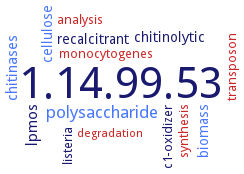1.14.99.53: lytic chitin monooxygenase
This is an abbreviated version!
For detailed information about lytic chitin monooxygenase, go to the full flat file.

Word Map on EC 1.14.99.53 
-
1.14.99.53
-
polysaccharide
-
chitinases
-
lpmos
-
recalcitrant
-
chitinolytic
-
cellulose
-
biomass
-
c1-oxidizer
-
analysis
-
synthesis
-
listeria
-
transposon
-
monocytogenes
-
degradation
- 1.14.99.53
- polysaccharide
- chitinases
-
lpmos
-
recalcitrant
-
chitinolytic
- cellulose
- biomass
-
c1-oxidizer
- analysis
- synthesis
-
listeria
- transposon
- monocytogenes
- degradation
Reaction
Synonyms
AA10, AA10A, AA9A, AO090102000501, BATR1942_08650, BURPS1710b_0114, CBM33A, CBP21, Cbp33A, CelS2, chitin-binding domain 3 protein, EF_0362, G15G9.090, GbpA, Jden_1381, lmo2467, LPMO10, LPMO10A, LPMO10B, LPMO10F, Micau_1630, PMO-2, RBAM17540, SCO0643, SGR_6855
ECTree
Advanced search results
Systematic Name
Systematic Name on EC 1.14.99.53 - lytic chitin monooxygenase
Please wait a moment until all data is loaded. This message will disappear when all data is loaded.
chitin, hydrogen-donor:oxygen oxidoreductase (N-acetyl-beta-D-glucosaminyl C1-hydroxylating/C4-dehdrogenating)
The enzyme cleaves chitin in an oxidative manner, releasing fragments of chitin with an N-acetylamino-D-glucono-1,5-lactone at the reducing end. The initially formed lactone at the reducing end of the shortened chitin chain quickly hydrolyses spontaneously to the aldonic acid. In vitro ascorbate can serve as reducing agent. The enzyme contains copper at the active site.


 results (
results ( results (
results ( top
top





